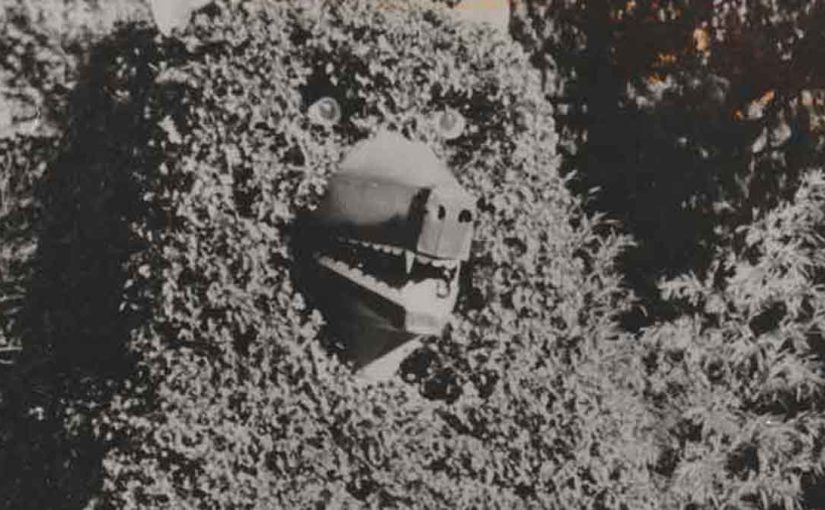Alder Creek is a little town half way between Sandy and Welches Oregon on today’s Highway 26.


Alder Creek is a little town half way between Sandy and Welches Oregon on today’s Highway 26.

For decades, travelers along U.S. Highway 26 in Oregon have been greeted by a unique roadside landmark: the towering Ivy Bear at Alder Creek. Covered in thick vines and steeped in local lore, this massive figure has become a beloved symbol of the Mount Hood area. Built as a tribute to a pet bear, it eventually collapsed, but thanks to a dedicated community, it rose again.
The story of the Ivy Bear begins with Gerald Wear, a deaf craftsman, dog trainer, and builder who lived in Alder Creek. Wear was widely known for his ingenuity and deep love for animals. Alongside training German Shepherds, he also cared for a bear that lived in a roadside cage. As travelers passed along the two-lane highway, many stopped to watch the bear, which quickly became an unofficial mascot.
Eventually, the bear passed away. According to local accounts, it died after consuming too many candy bars, soda pop, and bottle caps handed out by curious onlookers. Heartbroken, Wear felt compelled to honor the animal. He decided to create a much larger tribute: a towering ivy-covered bear that would stand beside the road for all to see.
In 1947, Wear began construction on what would become the Ivy Bear at Alder Creek. He built a wooden frame, wrapped it in chicken wire, and carefully planted ivy around the structure. Over the course of more than a year, the vines filled in, eventually covering the entire bear.
At the time, the figure was believed to be the largest ivy-covered structure in the world. Motorists quickly became accustomed to the sight of the massive bear keeping watch near the highway. To make the figure even more lifelike, Wear added a rear door and scaffolding inside that led up to the bear’s head. At night, he would climb inside and light its eyes with candles. Later, he upgraded them with old Volkswagen taillights.
Over time, the Ivy Bear at Alder Creek became even more popular. In fact, it eventually became better known than the businesses located on the property. Mount Hood skiers adopted a tradition of saluting the bear for good luck, and children often lifted their feet as they passed by.
Meanwhile, Wear continued working on creative projects in Alder Creek. In addition to the bear, he built homes and decorative water wheels. Although Wear passed away in 1972, his most famous creation remained standing—a lasting testament to his creativity and love for the area.
After nearly 40 years of standing tall, the Ivy Bear collapsed on June 18, 1984. A gentle breeze that evening was all it took to bring down the aging wooden structure. The bear toppled forward and landed on its tin snout.
Upon closer inspection, the cause became clear: the wooden beams at the base had rotted through. Without a strong foundation, the structure simply gave way. Although exterior damage was minimal, the bear could no longer stand upright.
The loss resonated with the community. Travelers slowed down, searching for the familiar landmark. Even the Portland Chamber of Commerce reached out to the property’s owners, eager to help restore the iconic roadside figure.
Recognizing the Ivy Bear’s cultural value, local residents and organizations launched a campaign to bring it back. In 1987, Ron Rhoades, owner of the Ivy Bear Restaurant, partnered with Michael P. Jones of the Cascade Geographic Society and the Friends of the Ivy Bear to start a fundraiser.
By 1990, their efforts paid off. The community raised enough money to rebuild the Ivy Bear—this time using a steel frame designed to withstand time and weather. Thanks to their perseverance, the Ivy Bear stood once again.
The bear’s revival brought renewed energy to the Mount Hood area. Locals and travelers alike celebrated the return of the iconic figure. Once more, the Ivy Bear stood proudly along Highway 26, welcoming visitors and honoring its unique history.
Today, the Ivy Bear remains a bit overgrown but continues to charm passersby. It stands not only as a tribute to Gerald Wear’s craftsmanship and compassion but also as a symbol of community pride. Next time you drive through Alder Creek, don’t forget to salute the bear—just like generations before you.